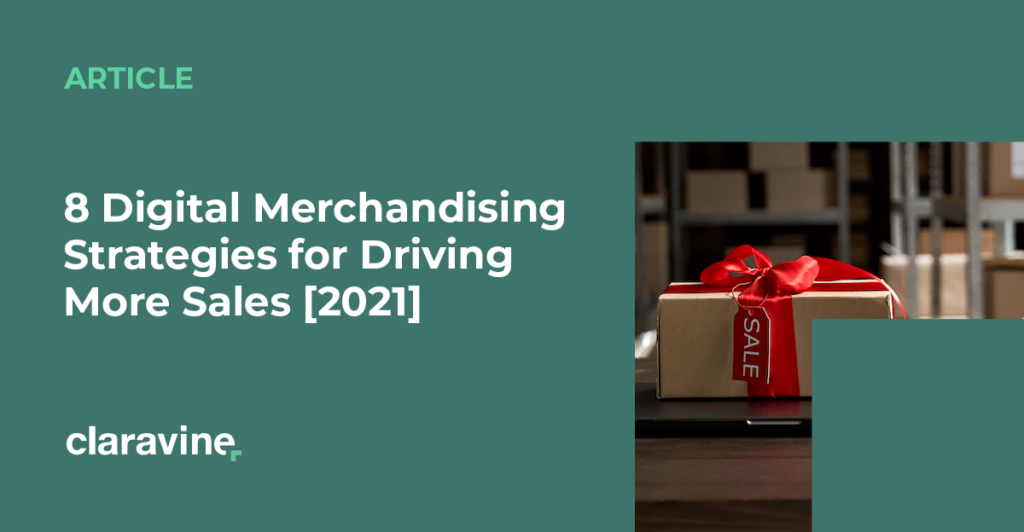Digital Merchandising: 8 Strategies for More Sales [2023]

Consumers have increasingly high expectations for their online shopping experiences.
Online business owners must not only mimic the look and feel of an in-store visit, but they must provide more convenience, personalization, and perks like free shipping.
No wonder modern ecommerce merchandising has become increasingly complex, requiring more technological investment, expertise, and strategic vision to attract, delight, and retain customers.
But with global ecommerce sales expected to reach $4.2 trillion this year, it’s worth evaluating your overall digital merchandising strategy.
Here are 8 strategies to consider investing in.
But first, let’s define what we’re talking about.
Table of Contents
What is Digital Merchandising?
Digital merchandising, also referred to as ecommerce merchandising, involves the positioning and sale of products online. Though it encompasses different strategies and tactics than traditional brick-and-mortar store merchandising, the objective is the same: attracting customers and driving sales.
A well-executed strategy will generate traffic, engagement, and convert browsers into buyers.
8 Ecommerce Merchandising Strategies to Boost Engagement and Sales
Obviously online shopping isn’t going anywhere. This year it’s expected to account for 15% of total US retail sales and 19.2% by 2024.
Here are ways you can ensure your online business gets a piece of that revenue.
1. Invest in a Home Page That Tells a Story
Your online store’s homepage is your storefront and signage; it’s the friendly sales associate extending a greeting to people who enter your “doors.”
Keep in mind that it also represents the first encounter many visitors will have with your brand. So it’s important you tell your story, share your values, feature a professional logo, include branded merchandise and provide clear reasons why they should stick around and buy from you. Offering assistance and providing a glimpse into what will be a well-organized and engaging shopping experience is important too.
2. Collect and Leverage Customer Data
Collecting and analyzing data about your customers — and visitors who didn’t complete a purchase — will inform the right digital merchandising strategy for your business and your customers.
Google Analytics and your ecommerce platform’s reporting and analytics app can monitor traffic and provide valuable information, such as:
- Visitor demographics — age, location, gender, etc.
- Amount of time visitors spend on your site
- Average order value (AOV)
- Search terms used to find your site
- Browsing habits across the web
- Shopper’s social activity —“pins,” “likes,” etc.
You can collect additional data by analyzing the activity within your own site through other means too:
- Split testing or A/B testing: To learn which page designs, layout, and verbiage drive the most conversions as well as the small changes you can make for improvement
- Heat maps: To identify and amplify the places on a page that promote the most engagement
- Polls and surveys: To find out what customers really think about the experience you provide
Taken altogether you’ll be better positioned to adapt to the changing needs and preferences of your customers. You also need to provide a more personalized experience for everyone.
3. Get Personal with Merchandise Recommendations
You’ll need more than a compelling brand story and optimized landing pages to drive sales and promote repeat business. You still need to offer the expertise and attentiveness of a sales associate who truly understands the customer — just in a different way.
Ecommerce merchandising relies on artificial intelligence to fulfil that role. “Artificial” is a bit of a misnomer though — all that extra information you gather builds genuine trust and connection with the customer.
When you’re in tune with your customers’ interests and preferences, you’re able to present the right product and the right time — not to mention you have the ability to inspire interest in complementary products that will suit them just perfectly.
4. Optimize Search to Make Shopping a Breeze
Being able to locate the product they want in the fewest clicks possible is a critical piece of a solid digital merchandising strategy. It requires a deep understanding of your customers and their search intent then building the shopping experience around it.
Here are a few practical tactics to ensure customers can find what they need.
- Using product synonyms: Avoid the dreaded “no results” message by grouping closely related, correlated words to accommodate global and regional searches (for example, diaper and nappy)
- Categorizing products for an initial narrowing while still inviting product exploration
- Positioning bestsellers, top rated, and trending product prominently for quick purchase
5. Perfect Visual Merchandising
Of course you can never truly replicate the in-person shopping experience — the ability to touch, smell, and taste just isn’t part of online shopping. That’s why visual merchandising is so important.
Here are some elements to keep in mind while developing the look and feel of your store.
- Color and layout and how each correlates to consumer behavior
- Where to position images for maximum impact (hint: heat map data comes in handy here)
- Mixing media types — video, dynamic and static images — for interest and appeal
So visual merchandising isn’t just about including high-resolution product images throughout your site — though it’s incredibly important. It’s about providing the kind of experience that encourages visitors to explore, linger, purchase, and come back again.
6. Promote Impulse Buys
If you frequent Costco you’re accustomed to making spur-of-the-moment purchases — probably a lot of them. Impulse buying is a huge sales driver for Costco and other brick-and-mortars.
They’re equally important to ecommerce stores. In fact, some studies suggest impulse purchases account for as much as 40% of sales.
But online stores don’t have all those endcap displays or must-haves at the register — enticements only the most focused, disciplined shopper can resist.
Still, ecommerce businesses must invoke that same feeling in their customers. Here’s how.
- Set free-shipping thresholds to encourage extra spending
- Provide incentives and promotional pricing
- Optimize your site for mobile to make it quick and easy to complete a purchase
- Grab visitors’ attention by using digital stickers or ribbon overlays for bestsellers, customer favorites, top rated, etc.
7. Display Product Reviews and Social Proof
93% of customers consult online reviews before they’ll buy a product — and they trust them as much as they trust personal recommendations.
So it’s important to amplify product reviews and social proof on your website as part of your overall digital marketing strategy. That means including snapshots of ratings, social media reviews, and logos representing your customers and media mentions.
Generate more buzz for your business by encouraging customers to share their purchase by integrating social share buttons into the shopping experience. It doesn’t hurt to offer an incentive to inspire more personal reviews and social shares too.
8. Leverage Content Marketing to Showcase Products
Creating an engaging, SEO-optimized blog about subjects related to your business or industry is an indirect but effective way to position your products.
Of course, you’ll need to know what’s important to your target customer and the keywords they use to find the products or solutions they’re seeking.
For example, if you have an organic supplements online store, your blog should include trending topics in health and wellness. Metabolic health supplements would be one topic to consider addressing. Of course you would include suggested products from your store (or just a gentle reminder that you sell organic supplements).
Set Your Online Store Up for Success
Online shoppers will click over to another store the moment they become frustrated with the shopping experience.
Implement an excellent digital merchandising strategy and they’ll be more likely to stick around and make a purchase at your ecommerce store.



